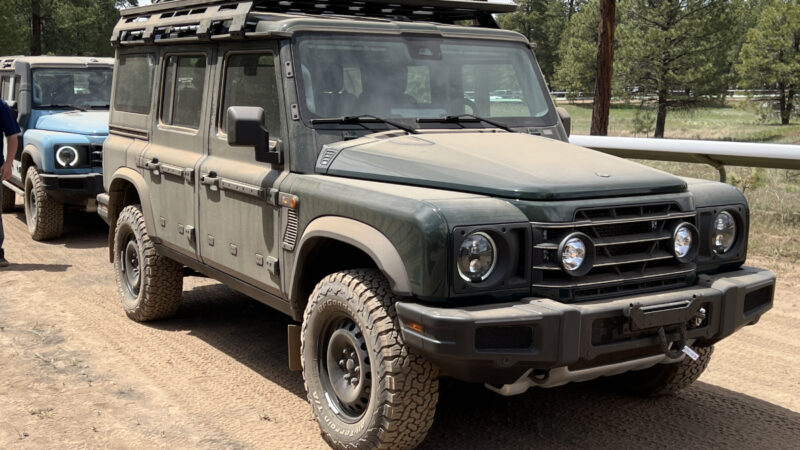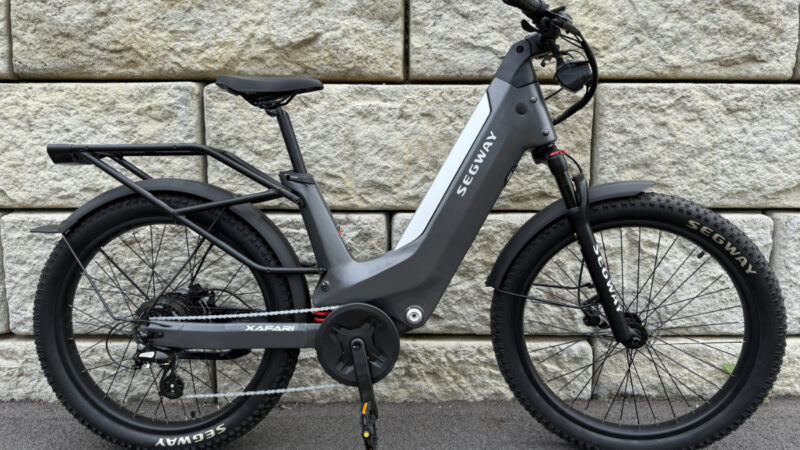How to Avoid an Epic RV Fail
Most of the time, the promise of RVing delivers a day like this: The sun is high, and the asphalt stretches to the horizon. Your well-aligned axles and plush suspension offer smooth transport to a campground alongside an idyllic body of water, where you deftly pull into a perfectly level site. You are, as everyone can see, Master of the Road.
Most of the time.
This is a story about the other times. When the wheels on the bus don’t go round and round. When the wind topples your trailer. When your clumpy sewage freezes solid. When the rig next door explodes at 4 a.m.
In the face of such harrowing tales of RVing gone wrong, we’ve sought expert tips for safety and preparedness, along with gear recommendations to keep your road trips worry-free. So you can remain Master of the Road. Most of the time.

Illustration by Tom Haugomat
Flat-Out Stranded
It happened to her: Not every blown tire has disaster potential, but some years back, author and full-time RVer Susan Shumsky was driving a remote stretch near the border of Arizona and New Mexico when she felt a jolt. “It sounded like an explosion behind me,” recalls Shumsky, who’s been full-timing since 1989. “I hadn’t hit anything, so I knew it was a tire.”
One of the rear tires on her driver’s side had blown apart, damaging the underside of her motorhome and leaving her stranded on the roadside in the desert. She eased the vehicle off the shoulder and onto a patch of dirt. And then she waited. And waited some more.
She stayed with her RV on the side of the road during the three days it took for a shop in Gallup to source a tire. When she finally made it to San Diego, Shumsky also had to replace water tanks, fenders, and stowage compartments. All told, damage from the blowout ran to nearly $13,000. — J.B.
PRO TIPS: Jacob Rigor, a certified RV repair technician outside Omaha, Nebraska, says that tire blowouts and other wheel-related issues are among the most common reasons his phone rings. He emphasizes the importance of inspecting tires frequently for factors like age, wear, and tread depth. Most important, though, is pressure. “You want to know as soon as possible when the tire pressure goes low,” he says. “If you have a blowout, the damage to your RV can be huge.” Just as important, Rigor tells RVers to have their wheels and bearings inspected every year. “Your whole wheel could fall off on the highway. It could catch fire. You could trash your whole axle if you don’t catch a problem in time.”
GEAR UP: If your rig doesn’t have a tire-pressure monitoring system, it’s not hard to install an aftermarket one like the TireMinder i10 RV TPMS. With four transmitters, the ability to display 10 tires at once, and accuracy to +/-1 PSI, it’s one of the best ways to prevent a blowout.
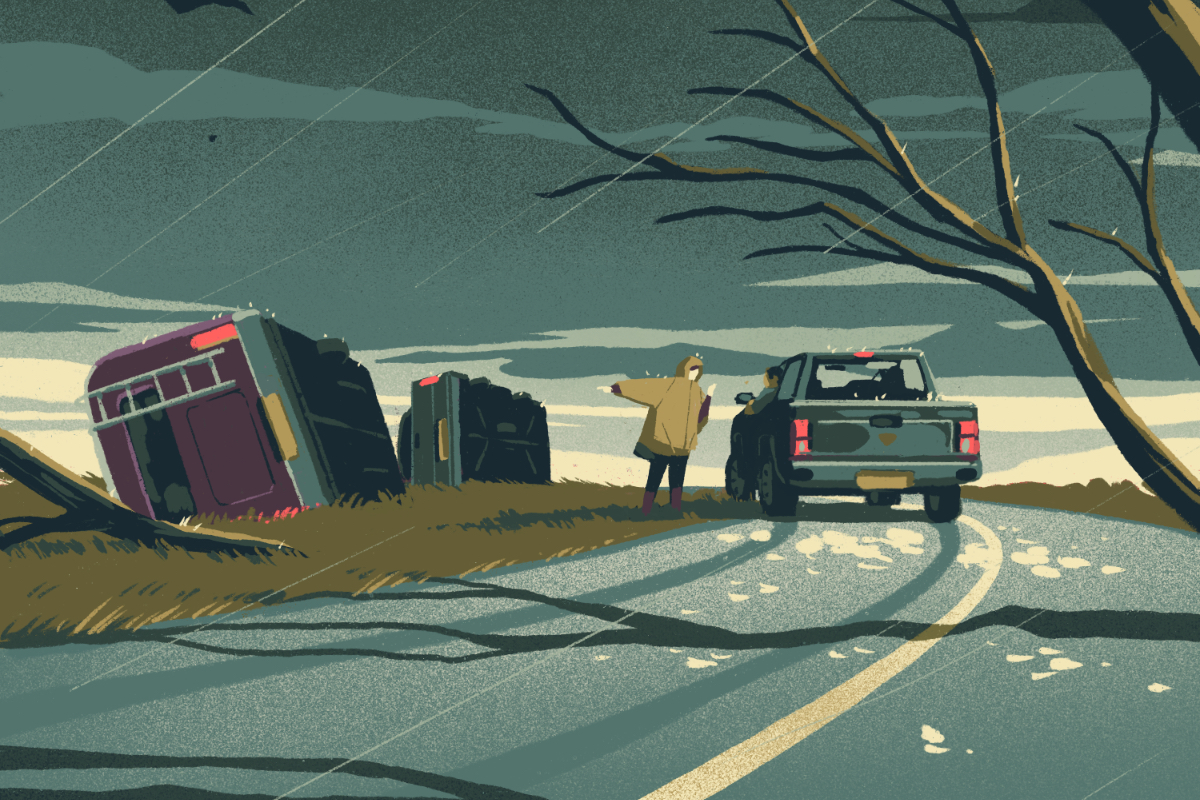
Illustration by Tom Haugomat
Big Gusts and an Eerie Sight
It could have happened to me: The wind in central Wyoming blows so reliably hard across Interstate 25 that it’s routine for authorities to close the highway. Even when it’s open, gusts regularly exceed 70 miles per hour.
It was a day like that several years ago when I was heading south on I–25 between Buffalo and Casper. Illuminated signs warned of hazardous conditions. When I stopped for gas, the gusts made it hard to open my truck door. I’d just gotten back on the road when I saw, in the northbound lane, every RVer’s nightmare: A fifth-wheel had jackknifed, tipped over, and split open like a Pillsbury dough can. The truck towing it was on its side, windows shattered, with personal belongings strewn across the median. No one was left at the scene. — J.B.
PRO TIPS: How does this happen? The primary culprit is usually what’s called “trailer sway,” which high winds can exacerbate. Essentially, lateral forces make a trailer wag side-to-side—and the longer it goes on, the greater the sway. To help avoid it, says RV tech Jason Rigor, be sure to load your trailer with weight distributed evenly—and ensure your tow vehicle has the proper capacity.
“It’s really common that RVers are ‘min-maxers’—meaning the minimum tow vehicle and the maximum trailer size,” Rigor says. “The most stable system is a larger tow vehicle and smaller trailer.” If your trailer starts swaying in the wind, he warns not to slam on the vehicle brakes. Instead, Rigor says, take your foot off the gas, then reach for the brake controller and engage the trailer brakes independently, which will help the trailer fall back in line with the tow vehicle.
Better still? Avoid traveling in high winds in the first place. “RVers need to pay attention to wind advisories,” Rigor says. “Don’t be afraid to pull over in a parking lot and turn your vehicle so it’s facing into the wind.”
GEAR UP: A sway-control hitch can help prevent wind disasters by redistributing weight and slowing a trailer’s side-to-side action. The ProPride 3P has a reputation as one of the best, thanks to a design that projects a trailer’s pivot point forward and off the hitch ball.

Illustration by Tom Haugomat
Where There’s Smoke
It happened to them: Mark and Teri Nisbett sold what they could, donated the rest, and hit the road in January 2022 for a life of full-time RVing in their Keystone Montana High Country. They made it as far as an RV park in Albany, Oregon, before disaster struck a few weeks later.
Mark awoke in the wee hours to an ominous snap, crackle, and pop. Through his window, he saw an orange glow, so he woke Teri and opened the side door to find flames shooting out from under the trailer next door. “I knew at that moment that the rig was going up,” he says. He pounded on his neighbor’s trailer, but no one was home. After making sure Teri was safe, he ran down the row of RVs in his skivvies, banging on windows and shouting—saving others’ lives rather than his own property.
The fire spread quickly, burning four trailers to the ground, including the Nisbetts’, destroying what personal possessions they had left. It was unclear what started the blaze, but the first rig to burn may have had a propane leak. According to Nisbett, the owner was running space heaters inside. Unattended, the trailer was a tinderbox.
Insurance helped the Nisbetts replace their fifth-wheel and some belongings, but some things they’ll never get back. They’re still on the road, though—and more fire-conscious than ever. — J.B.
PRO TIPS: Local fire departments report some 4,200 RV fires a year, according to the US Fire Administration, which urges routine checks of propane lines and connections with a leak-detection device. These days, the Nisbetts keep personal belongings in a fire-safe box, and they suggest installing portable fire extinguishers in every compartment where a fire might erupt. Heating a unit while you’re not in it, moreover, is almost always a bad idea, and it’s not uncommon for electrical components in RVs to short and spark. “If you’re going to leave overnight,” Mark Nisbett stresses, “turn your damn propane off.”
GEAR UP: Most rigs come with sensors that tell you how full your batteries and water tanks are, but you’re often left guessing about the status of your propane tank. The Mopeka Pro Check Sensor is a simple device that attaches to any steel propane tank via magnets and allows you to monitor levels using an app—which can tip you off to a potentially catastrophic leak.
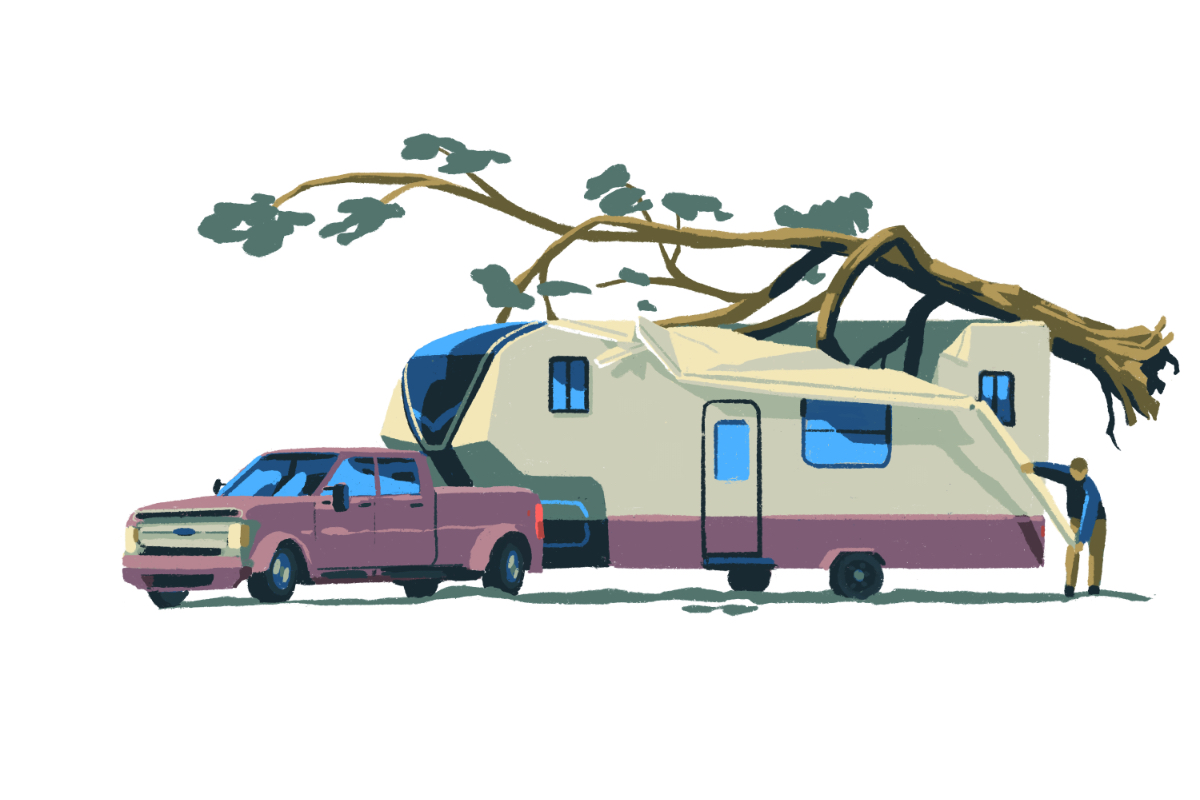
Illustration by Tom Haugomat
Beware the Limb of Doom
It happened to him: Jason Hill had only towed his brand-new fifth-wheel a handful of times. Mostly, he’d used the 40-foot Grand Design Momentum 350G as a toy hauler, going to and from the motorcycle track near his northern Virginia home. Then, last summer, he set off on a 450-mile journey to visit his mother in Ohio. Getting there went great.
But in a rush to get home and back to work, he started his return trip before dawn, driving on what he calls “very, very backcountry roads.” A half-mile from the RV park where he’d stayed, traveling about 35 miles per hour, Hill heard a crash and bang. “Then the whole thing jerked, and I knew what had happened,” he says. “When I hit those branches, I was like, ‘Please god, no.’ I was praying I’d only knocked the air-conditioning unit off.”
He’d done worse. When Hill pulled over, he found a 2.5-foot hole in the top of the trailer. His awning was barely hanging on, and he’d bent, scratched, and impaled the sidewall. Weary and angry, he drove seven hours home, where a $45,000 repair awaited. “I was like, let me just get this thing home and set it on fire,” he says.
But after a six-month repair, Hill resolved to hit the road again with a greater sense of caution. Lessons learned? “Never leave at 2:30 in the morning,” he says. “And always be spotting things. Be alert—don’t be in a rush. Slower is better than wrecked.” — J.B.
PRO TIPS: Know your rig’s height to the inch, says RV tech Jacob Rigor, who frequently hears from folks with damage from misjudged clearance. Sometimes an AC unit is knocked off by an underpass; sometimes rigs are totaled.
“You have to measure it,” Rigor says. “Make a sticker with your height and post it on your dashboard, so when a bridge is coming up you can reference it.” Rigor also stresses the importance of route-finding: Staying on interstates and main roads is a great start (think: where can semi trucks go?), but planning your journey step-by-step is paramount.
GEAR UP: Apps can help. RV Life Trip Wizard is one of several that can customize routes based on a rig’s dimensions and other restrictions. The Garmin RV 890 is a large-screen dedicated GPS navigator that does the same (and more).
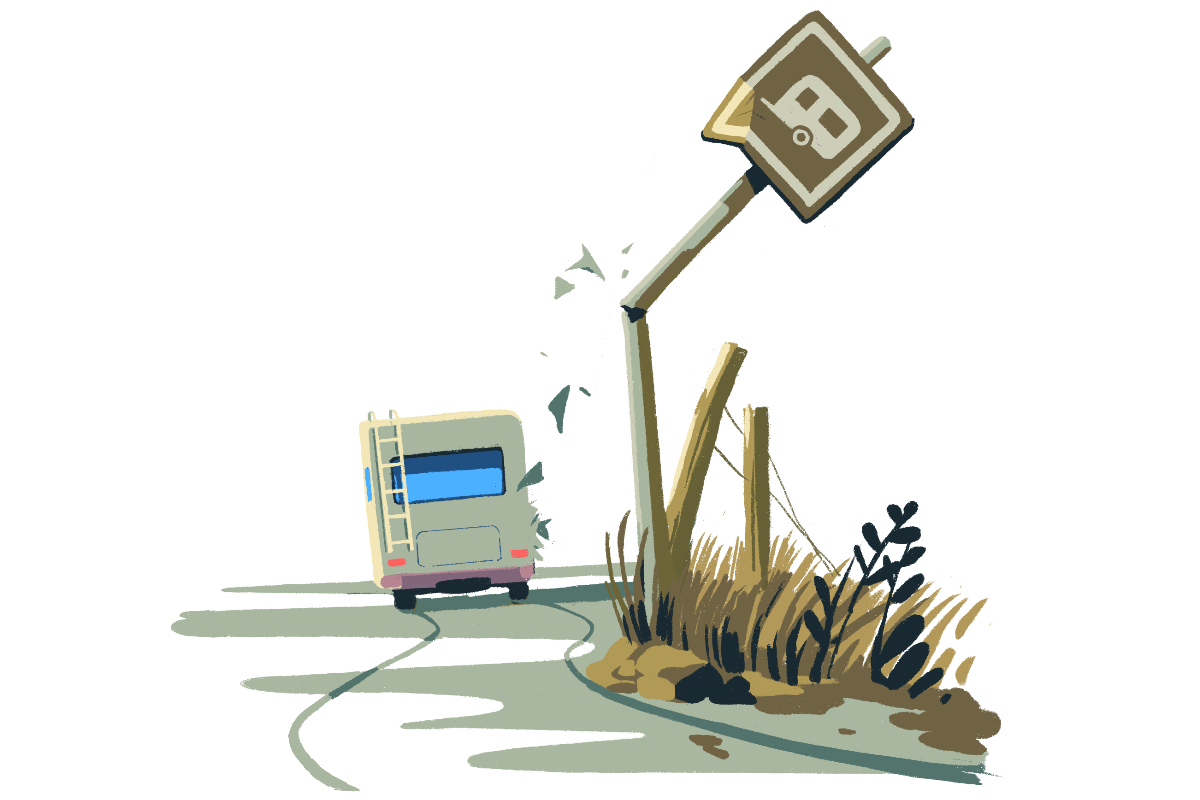
Illustration by Tom Haugomat
Heck of a Mess
It happened to me: The campground we were headed to was 23 miles down a dirt road in a remote forest in northern New Mexico. My wife and I had towed our 2005 Airstream Bambi down that road before, but it had since become severely washboarded. And in our rush to make the campsite before dark, we neglected to do what we usually do and air down the trailer’s tires before hitting gravel.
When we arrived at camp, we opened the Airstream’s door to find an apocalyptic scene. Cabinets had been jostled open, and their contents were everywhere. The refrigerator door had popped off its hinges and unleashed a torrent of food and beverages all over the floor. There was a hummus eruption, blueberries had found their way into the trailer’s every crevice, and several cans of sparkling water had exploded, leaving everything sopping wet.
We spent the next three hours cleaning and resecuring cabinets with zip ties and duct tape. We ended up losing a few meals and a favorite rug, victim of a guacamole spill. We also lost a good bit of sleep that night. — B.R.
PRO TIPS: A deflator and portable compressor are essential tools to prep tires for off-pavement travel (and air them back up for the highway). Aim for around 60 percent of street pressure as a starting point. Storage bins in cabinets, and the fridge can keep things secured when the road gets bumpy. We like mesh cargo nets, too, for small, loose items. For an easy, cheap way to add extra security to any suspect cabinet door, grab a roll of blue painter’s tape.
GEAR UP: The ARB505 E-Z Tire Deflator works rapidly by removing the valve core, and it gives a more detailed PSI reading than the gauge you’d buy in a gas station. For letting air out, it beats the pants off using a stick.
Black Tank Blues
It happened to me: After a late-season trip in my Airstream a couple of years ago, I made an amateur RVer mistake: forgetting to drain the tanks on the way home before temperatures dipped below freezing. The next morning, amid light snow and a stout wind, I spent hours in my yard with the sewage hose (a.k.a, the Stinky Slinky) hooked up to my septic tank, attempting to thaw a frozen dump valve with a hair dryer and boiling water. And not only was the valve itself frozen shut, the black tank’s contents had frozen as well.
Eventually, after a fair bit of cursing and numbing my fingers, I was able to thaw the valve and then coax what can only be described as a semi-frozen “poopsicle” from the trailer’s bowels. The experience was gnarly enough that I later ripped the black tank and traditional flush toilet out of the Airstream and replaced them with a composting toilet—a surprisingly easy DIY project. After using it for over a year now, I’m not sure why anyone would opt for a traditional black-tank setup. — B.R.
PRO TIPS: If you stick with your black tank, you can avoid situations like mine by doing a couple of things. First, unless you have a true four-season trailer, don’t use your toilet in cold temperatures. Next, avoid the buildup of solids by flushing with plenty of water—black tanks require enough water in them to work properly. Finally, if you’re hooked up at a campground, keep the dump valve to your blank tank closed until it’s time to leave—otherwise you’ll risk, ahem, things not draining properly.
But hear me out! Composters don’t require water to flush and solve so many problems associated with black tanks: poop pyramids, unwelcome smells, dump station mishaps, and, yes, even poopsicles. The biggest selling point for me, however, is the serious amount of water they save—all that extra water in your fresh tank can be saved for drinking, showering, and staying off-grid longer.
GEAR UP: The OGO Origin composting toilet separates liquid from solid waste, has an electric actuator that stirs the compost, and is good for 25 to 30 uses before it needs to be emptied into a compost pile or into a bag and thrown away (though the liquid bin needs to be emptied every few days).

Illustration by Tom Haugomat
The Tale of the Runaway Camper
It happened to her: Author and full-time RVer Susan Shumsky mostly travels alone. But a few decades back, during her first year on the road, she invited a male companion to join her on a trip to California’s Mount Shasta. On the way, a friend’s driveway proved too steep for her leveling jacks, so she set one on a tree stump, keeping her 31-foot Airstream relatively even for the duration of their stay.
As they readied to leave, though, Shumsky’s guy pal—who claimed he could hook up the camper alone—tried to undo her MacGyvered leveling system. Shumsky heard screams and ran out to find him braced against the iconic aluminum skin, holding back thousands of pounds. “Obviously, he couldn’t,” she recalls. He jumped out of the way, and the trailer disconnected from the tow vehicle, started rolling—first slowly, then picking up speed. By some miracle, it left the driveway, careened several hundred feet down the road, and came to a stop without striking anything.
Shumsky’s Airstream survived. The relationship did not. “That guy was not invited back on the road after that incident,” she says. — J.B.
PRO TIPS: Leveling and chocking are essential skills, and getting a process dialed often requires teamwork. Take it from full-timers and YouTubers Bob and Barb Hettesheimer, who’ve developed an extensive checklist for arriving and departing in their 44-foot Forest River Riverstone fifth-wheel.
“When you’re setting up and taking down, it’s important that you’re communicating well,” Barb says—for the Hettesheimers, it’s over walkie-talkies when parking. The couple uses rubber wheel chocks and snap leveling pads, always makes sure their tow vehicle’s emergency brake is on, and never disconnects the camper without chocks in place. Also, Bob says, “Don’t play anyone else’s game.” People may want to help you, but it’s important to stick to your system.
GEAR UP: Interlocking blocks made from high-impact plastic, Lynx Levelers are easy to stack in a pyramid shape at a desired height, then simply drive an RV onto. They can also be used under stabilizers and jacks (though they’re not a substitute for tire chocks).
Three More Must-Have Disaster Preventers
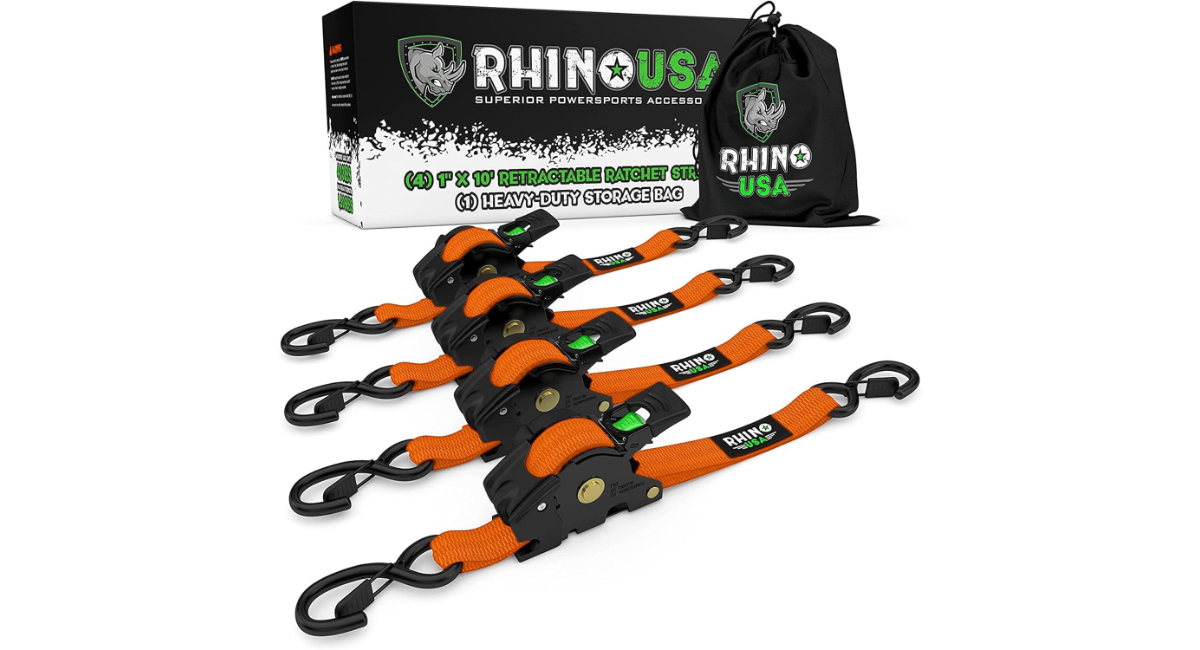
Photo Credit: Rhino USA
Whether it’s a wobbly AC unit or an unsecured bin, Rhino USA Retractable Ratchet Straps can be deployed in a pinch to lock down your rig. They have a max break strength of more than 3,000 pounds and automatically retract the excess length— meaning you won’t have any straps flapping in the breeze.
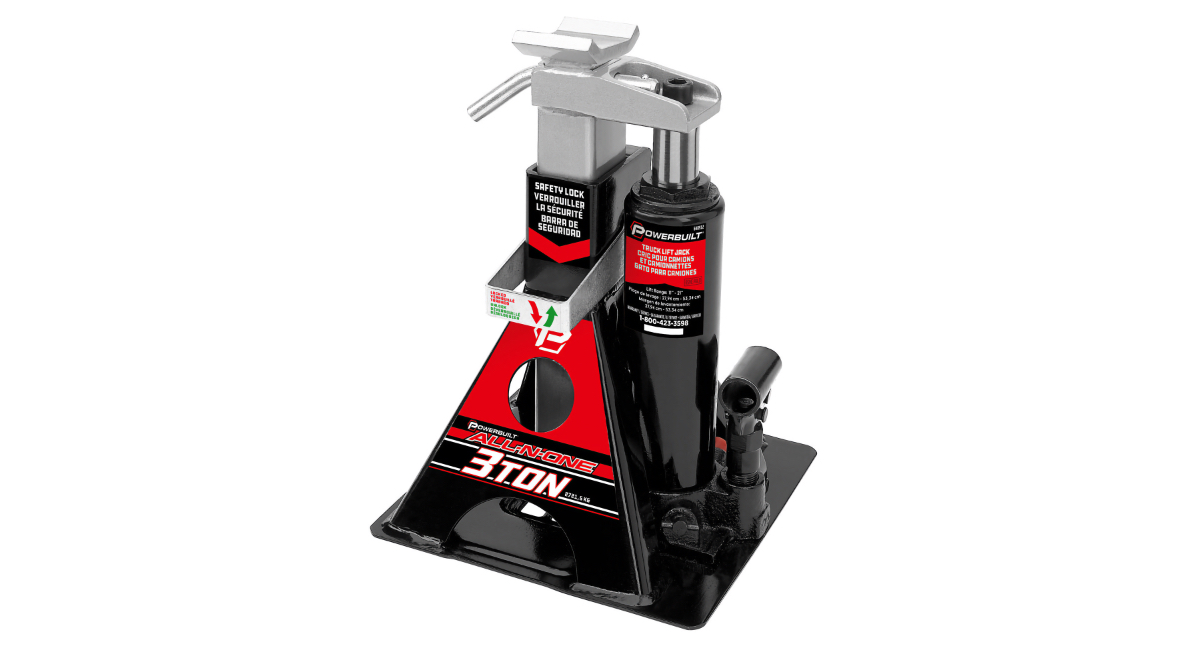
Photo Credit: Powerbuilt
A standard bottle jack won’t cut it for roadside RV repairs or tire changes. The Powerbuilt 3-Ton All-in-One Unijack supports up to 6,000 pounds, has a wide base for extra stability on soft surfaces, and acts as both a bottle jack and a stand, thanks to an automatic locking mechanism that engages while you lift the rig.
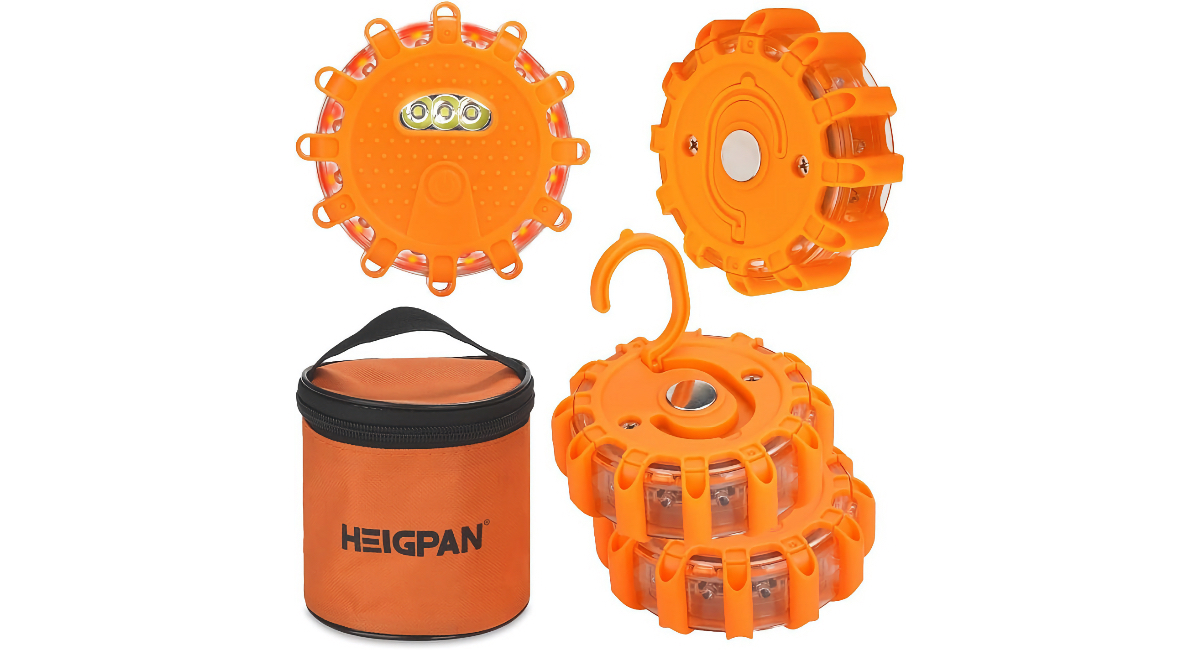
Photo Credit: Heigpan
Visibility is crucial if you break down at night. Heigpan LED Road Flares have nine flashing modes, including an SOS mode, and can be seen from a mile away in the dark. Plus, their magnetic base makes them easy to attach to a vehicle.
This article originally appeared in Wildsam magazine. For more Wildsam content, sign up for our newsletter.
The post How to Avoid an Epic RV Fail appeared first on RV.com.
Source: https://www.rv.com/servicing-care/how-to-avoid-an-epic-rv-fail/



